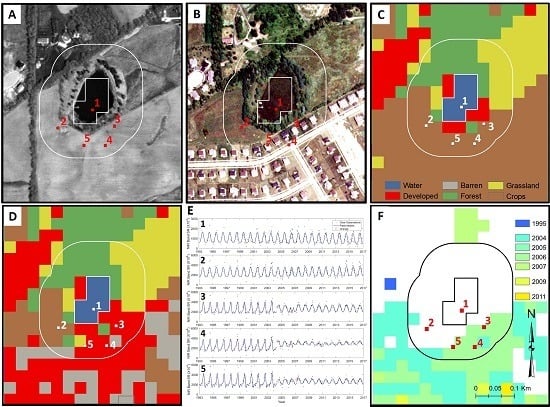Land-Cover Changes to Surface-Water Buffers in the Midwestern USA: 25 Years of Landsat Data Analyses (1993–2017)
Abstract
1. Introduction
- What is the magnitude, spatial distribution, and annual rate of LULC change across three Landsat footprints (nearly 100,000 km2) of the Midwestern US?
- How has LULC change occurred over time in buffers surrounding different water body sizes within the three study areas?
2. Materials and Methods
2.1. Study Area
2.2. Data Acquisition and Preprocessing
2.2.1. Landsat Data Downloading and Preprocessing
2.2.2. Land Cover Data Downloading and Processing
2.3. Change Detection Model Implementation and Assessment
2.3.1. Continuous Change Detection and Classification (CCDC) algorithm
2.3.2. Random Forest Training and Classification
2.3.3. Classification Agreement with NLCD
2.4. Data Analyses
3. Results
3.1. Thematic Classification Characterization
3.2. Spatiotemporal LULC Change Dynamics at Footprint Level
3.3. Spatiotemporal LULC in Surface Water Buffers
3.3.1. LULC Change in Water Body Buffers Compared to Footprint-Scale
3.3.2. LULC Change in Buffers by Water Body Sizes
4. Discussion
Dynamics of LULC Change in the Midwestern US
5. Conclusions
Author Contributions
Funding
Acknowledgments
Conflicts of Interest
References
- Bonan, G.B. Frost Followed the Plow: Impacts of Deforestation on the Climate of the United States. Ecol. Appl. 1999, 9, 1305–1315. [Google Scholar] [CrossRef]
- Adegoke, J.O.; Pielke, R.; Carleton, A.M. Observational and modeling studies of the impacts of agriculture-related land use change on planetary boundary layer processes in the central U.S. Agric. For. Meteorol. 2007, 142, 203–215. [Google Scholar] [CrossRef]
- Martin, B.A.; Shao, G.; Swihart, R.K.; Parker, G.R.; Lang, T. Implications of shared edge length between land cover types for landscape quality: the case of Midwestern US, 1940–1998. Landsc. Ecol. 2008, 23, 391–402. [Google Scholar] [CrossRef]
- Gupta, S.C.; Kessler, A.C.; Brown, M.K.; Zvomuya, F. Climate and agricultural land use change impacts on streamflow in the upper midwestern United States. Water Resour. Res. 2015, 51, 5301–5317. [Google Scholar] [CrossRef]
- Neri, A.; Villarini, G.; Slater, L.J.; Napolitano, F. On the statistical attribution of the frequency of flood events across the U.S. Midwest. Adv. Water Resour. 2019, 127, 225–236. [Google Scholar] [CrossRef]
- Lin, M.; Huang, Q. Exploring the relationship between agricultural intensification and changes in cropland areas in the US. Agric. Ecosyst. Environ. 2019, 274, 33–40. [Google Scholar]
- Radeloff, V.C.; Hammer, R.B.; Stewart, S.I. Rural and Suburban Sprawl in the U.S. Midwest from 1940 to 2000 and Its Relation to Forest Fragmentation. Conserv. Biol. 2005, 19, 793–805. [Google Scholar] [CrossRef]
- Jones, K.B.; Neale, A.C.; Wade, T.G.; Wickham, J.D.; Cross, C.L.; Edmonds, C.M.; Loveland, T.R.; Nash, M.S.; Riitters, K.H.; Smith, E.R. The consequences of landscape change on ecological resources; An assessment of the United States Mid-Atlantic region, 1973–1993. Ecosyst. Health. 2001, 7, 229–242. [Google Scholar] [CrossRef]
- Tomer, M.D.; Schilling, K.E. A simple approach to distinguish land-use and climate-change effects on watershed hydrology. J. Hydrol. 2009, 376, 24–33. [Google Scholar] [CrossRef]
- Hodgkins, G.A.; Dudley, R.W.; Archfield, S.A.; Renard, B. Effects of climate, regulation, and urbanization on historical flood trends in the United States. J. Hydrol. 2019, 573, 697–709. [Google Scholar] [CrossRef]
- Mishra, V.; Cherkauer, K.A.; Niyogi, D.; Lei, M.; Pijanowski, B.C.; Ray, D.K.; Bowling, L.C.; Yang, G. A regional scale assessment of land use/land cover and climatic changes on water and energy cycle in the upper Midwest United States. Int. J. Climatol. 2010, 30, 2025–2044. [Google Scholar] [CrossRef]
- Euliss, J.N.H.; Mushet, D.M. Water-Level Fluctuation in Wetlands as a Function of Landscape Condition in the Prairie Pothole Region. Wetlands 1996, 16, 587–593. [Google Scholar] [CrossRef]
- Luo, H.-R.; Smith, L.M.; Allen, B.L.; Haukos, D.A. Effects of sedimentation on playa wetland volume. Ecol. Appl. 1997, 7, 247–252. [Google Scholar] [CrossRef]
- Preston, T.M.; Sojda, R.S.; Gleason, R.A. Sediment accretion rates and sediment composition in Prairie Pothole wetlands under varying land use practices, Montana, United States. J. Soil Water Conserv. 2013, 68, 199–211. [Google Scholar] [CrossRef]
- Lane, C.R.; Autrey, B.C. Sediment accretion and accumulation of P, N and organic C in depressional wetlands of three ecoregions of the United States. Mar. Freshw. Res. 2017, 68, 2253–2265. [Google Scholar] [CrossRef]
- Martinuzzi, S.; Januchowski-Hartley, S.R.; Pracheil, B.M.; McIntyre, P.B.; Plantinga, A.J.; Lewis, D.J.; Radeloff, V.C. Threats and opportunities for freshwater conservation under future land use change scenarios in the United States. Glob. Chang. Biol. 2013, 20, 113–124. [Google Scholar] [CrossRef]
- Marton, J.M.; Creed, I.F.; Lewis, D.; Lane, C.R.; Basu, N.; Cohen, M.J.; Craft, C. Geographically isolated wetlands are important biogeochemical reactors on the landscape. Bioscience 2015, 65, 408–418. [Google Scholar] [CrossRef]
- Mehaffey, M.; Smith, E.; Van Remortel, R.; Midwest, U.S. landscape change to 2020 driven by biofuel mandates. Ecol. Appl. 2012, 22, 8–19. [Google Scholar] [CrossRef]
- Creed, I.F.; Lane, C.R.; Serran, J.N.; Alexander, L.C.; Basu, N.B.; Calhoun, A.J.K.; Christensen, J.R.; Cohen, M.J.; Craft, C.; D’Amico, E.; et al. Enhancing protection for vulnerable waters. Nat. Geosci. 2017, 10, 809–815. [Google Scholar] [CrossRef]
- Ali, G.; English, C. Phytoplankton blooms in Lake Winnipeg linked to selective water-gatekeeper connectivity. Sci. Rep. 2019, 9, 8395. [Google Scholar] [CrossRef]
- Golden, H.E.; Rajib, A.; Lane, C.R.; Christensen, J.R.; Wu, Q.; Mengistu, S. Non-floodplain Wetlands Affect Watershed Nutrient Dynamics: A Critical Review. Environ. Sci. Technol. 2019, 53, 7203–7214. [Google Scholar]
- Evenson, G.R.; Golden, H.E.; Lane, C.R.; McLaughlin, D.L.; D’Amico, E. Depressional Wetlands Affect Watershed Hydrological, Biogeochemical, and Ecological Functions. Ecol. Appl. 2018, 28, 953–966. [Google Scholar] [CrossRef] [PubMed]
- Cheng, F.Y.; Basu, N.B. Biogeochemical hotspots: Role of small water bodies in landscape nutrient processing. Water Resour. Res. 2017, 53, 5038–5056. [Google Scholar] [CrossRef]
- Van Meter, K.J.; Basu, N.B. Signatures of human impact: size distributions and spatial organization of wetlands in the Prairie Pothole landscape. Ecol. Appl. 2015, 25, 451–465. [Google Scholar] [CrossRef] [PubMed]
- Serran, J.N.; Creed, I.F. New mapping techniques to estimate the preferential loss of small wetlands on prairie landscapes. Hydrol. Process. 2016, 30, 396–409. [Google Scholar] [CrossRef]
- Wright, C.K.; Wimberly, M.C. Recent land use change in the Western Corn Belt threatens grasslands and wetlands. Proc. Natl. Acad. Sci. USA 2013, 110, 4134–4139. [Google Scholar] [CrossRef]
- Gramlich, A.; Stoll, S.; Stamm, C.; Walter, T.; Prasuhn, V. Effects of artificial land drainage on hydrology, nutrient and pesticide fluxes from agricultural fields – A review. Agric. Ecosyst. Environ. 2018, 266, 84–99. [Google Scholar]
- Capel, P.D.; McCarthy, K.A.; Coupe, R.H.; Grey, K.M.; Amenumey, S.E.; Baker, N.T.; Johnson, R.L. Agriculture — A river runs through it — The connections between agriculture and water quality; U.S.G.S. Circular 1433; U.S. Geological Survey: Reston, VA, USA, 2018.
- Mayer, P.M.; Reynolds, S.K., Jr.; McCutchen, M.D.; Canfield, T.J. Meta-Analysis of Nitrogen Removal in Riparian Buffers. J. Environ. Qual. 2007, 36, 1172–1180. [Google Scholar] [CrossRef]
- Noe, G.; Hupp, C.; Rybicki, N. Hydrogeomorphology Influences Soil Nitrogen and Phosphorus Mineralization in Floodplain Wetlands. Ecosystems 2013, 16, 75–94. [Google Scholar] [CrossRef]
- Brown, M.T.; Vivas, M.B. A Landscape Development Intensity Index. Ecol. Monit. Assess. 2005, 101, 289–309. [Google Scholar] [CrossRef]
- McCauley, L.A.; Anteau, M.J.; van der Burg, M.P.; Wiltermuth, M.T. Land use and wetland drainage affect water levels and dynamics of remaining wetlands. Ecosphere 2015, 6, 92. [Google Scholar] [CrossRef]
- Ntelekos, A.A.; Oppenheimer, M.; Smith, J.A.; Miller, A.J. Urbanization, climate change and flood policy in the United States. Clim. Chang. 2010, 103, 597–616. [Google Scholar] [CrossRef]
- Zhu, Z.; Woodcock, C.E. Continuous change detection and classification of land cover using all available Landsat data. Remote Sens. Environ. 2014, 144, 152–171. [Google Scholar] [CrossRef]
- Zhu, Z.; Woodcock, C.E.; Holden, C.; Yang, Z. Generating synthetic Landsat images based on all available Landsat data: Predicting Landsat surface reflectance at any given time. Remote Sens. Environ. 2015, 162, 67–83. [Google Scholar] [CrossRef]
- National Assessment Synthesis Team. Climate Change Impacts on the United States: The Potential Consequences of Climate Variability and Change; US Global Change Research Program: Washington, DC, USA, 2000.
- United States Department of Agriculture, Natural Resources Conservation Service. Land Resource Regions and Major Land Resource Areas of the United States, the Caribbean, and the Pacific Basin. U.S. Department of Agriculture Handbook 296; U.S. Department of Agriculture: Washington, DC, USA, 2006.
- Wuebbles, D.J.; Hayhoe, K. Climate Change Projections for the United States Midwest. Mitig. Adapt. Strateg. Glob. Chang. 2004, 9, 335–363. [Google Scholar] [CrossRef]
- Dahl, T.E. Wetlands - Losses in the United States, 1780’s to 1980’s; U.S. Department of Interior, Fish and Wildlife Service: Washington, DC, USA, 1990.
- Christensen, J.; Nash, M.S.; Neale, A. Spatial distributions of small water body types in modified landscapes: lessons from Indiana, USA. Ecohydrology 2016, 9, 122–137. [Google Scholar] [CrossRef]
- Multi-Resolution Land Characteristics Consortium. 2001 NLCD Land Cover Data. Available online: https://www.mrlc.gov/data (accessed on 1 May 2018).
- Hansen, M.C.; Loveland, T.R. A review of large area monitoring of land cover change using Landsat data. Remote Sens. Environ. 2012, 122, 66–74. [Google Scholar] [CrossRef]
- U.S.G.S. Earth Explorer. Available online: https://earthexplorer.usgs.gov/ (accessed on 1 May 2018).
- Vermote, E.F.; El Saleous, N.; Justice, C.O.; Kaufman, Y.J.; Privette, J.L.; Remer, L.; Roger, J.C.; Tanré, D. Atmospheric correction of visible to middle-infrared EOS-MODIS data over land surfaces: Background, operational algorithm and validation. J. Geophys. Res. Atmos. 1997, 102, 17131–17141. [Google Scholar] [CrossRef]
- GERSLab. Function of mask (Fmask): Automated clouds, cloud shadows, and snow masking for Landsats 4-8 and Sentinel-2 images. Available online: https://sites.google.com/view/gersl/tools (accessed on 1 May 2018).
- Zhu, Z.; Wang, S.; Woodcock, C.E. Improvement and expansion of the Fmask algorithm: cloud, cloud shadow, and snow detection for Landsats 4–7, 8, and Sentinel 2 images. Remote Sens. Environ. 2015, 159, 269–277. [Google Scholar] [CrossRef]
- Zhu, Z.; Gallant, A.L.; Woodcock, C.E.; Pengra, B.; Olofsson, P.; Loveland, T.R.; Jin, S.; Dahal, D.; Yang, L.; Auch, R.F. Optimizing selection of training and auxiliary data for operational land cover classification for the LCMAP initiative. ISPRS J. Photogramm. Remote Sens. 2016, 122, 206–221. [Google Scholar] [CrossRef]
- Foga, S.; Scaramuzza, P.L.; Guo, S.; Zhu, Z.; Dilley, R.D.; Beckmann, T.; Schmidt, G.L.; Dwyer, J.L.; Joseph Hughes, M.; Laue, B. Cloud detection algorithm comparison and validation for operational Landsat data products. Remote Sens. Environ. 2017, 194, 379–390. [Google Scholar] [CrossRef]
- Fu, P.; Weng, Q. A time series analysis of urbanization induced land use and land cover change and its impact on land surface temperature with Landsat imagery. Remote Sens. Environ. 2016, 175, 205–214. [Google Scholar] [CrossRef]
- Breiman, L.; Friedman, J.; Stone, C.J.; Olshen, R.A. Classification and Regression Trees; CRC Press: Boca Raton, FL, USA, 1984. [Google Scholar]
- Pengra, B.; Gallant, A.; Zhu, Z.; Dahal, D. Evaluation of the Initial Thematic Output from a Continuous Change-Detection Algorithm for Use in Automated Operational Land-Change Mapping by the U.S. Geological Survey. Remote Sens. 2016, 8, 811. [Google Scholar] [CrossRef]
- Congalton, R.G. A review of assessing the accuracy of classifications of remotely sensed data. Remote Sens. Environ. 1991, 37, 35–46. [Google Scholar] [CrossRef]
- Stehman, S.V.; Czaplewski, R.L. Design and Analysis for Thematic Map Accuracy Assessment. Remote Sens. Environ. 1998, 64, 331–344. [Google Scholar] [CrossRef]
- Maimaitijiang, M.; Ghulam, A.; Sandoval, J.S.O.; Maimaitiyiming, M. Drivers of land cover and land use changes in St. Louis metropolitan area over the past 40 years characterized by remote sensing and census population data. Int. J. Appl. Earth Obs. Geoinf. 2015, 35, 161–174. [Google Scholar] [CrossRef]
- Lane, C.R.; D’Amico, E.; Autrey, B.C. Isolated Wetlands of the Southeastern United States: Abundance and Expected Condition. Wetlands 2012, 32, 753–767. [Google Scholar] [CrossRef]
- Hijmans, R.J.; van Etten, J.; Sumner, M.; Cheng, J.; Bevan, A.; Bivand, R.; Busetto, L.; Canty, M.; Forrest, D.; Ghosh, A.; et al. raster: Geographic Data Analysis and Modeling. 2019. Available online: https://CRAN.R-project.org/package=raster (accessed on 1 September 2019).
- Bivand, R.; Keitt, T.; Rowlingson, B.; Pebesma, E.; Sumner, M.; Hijmans, R.; Rouault, E.; Warmerdam, F.; Ooms, J.; Rundel, C. rgdal: Bindings for ’Geospatial’ Data Abstraction Library. 2019. Available online: https://CRAN.R-project.org/package=rgdal (accessed on 1 September 2019).
- Bivand, R.; Rundel, C.; Pebesma, E.; Stuetz, R.; Hufthammer, K.O.; Giraudoux, P.; Davis, M.; Santilli, S. rgeos: Interface to Geometry Engine - Open Source (’GEOS’). 2019. Available online: https://CRAN.R-project.org/package=rgeos (accessed on 1 September 2019).
- Pebesma, P.; Bivand, R.; Racine, E.; Sumner, M.; Cook, I.; Keitt, T.; Lovelace, R.; Wickham, H.; Ooms, J.; McCller, K.; et al. sf: Simple Features for R. 2019. Available online: https://CRAN.R-project.org/package=sf (accessed on 1 September 2019).
- Wickham, J.; Stehman, S.V.; Gass, L.; Dewitz, J.A.; Sorenson, D.G.; Granneman, B.J.; Poss, R.V.; Baer, L.A. Thematic accuracy assessment of the 2011 National Land Cover Database (NLCD). Remote Sens. Environ. 2017, 191, 328–341. [Google Scholar] [CrossRef]
- Olofsson, P.; Foody, G.M.; Herold, M.; Stehman, S.V.; Woodcock, C.E.; Wulder, M.A. Good practices for estimating area and assessing accuracy of land change. Remote Sens. Environ. 2014, 148, 42–57. [Google Scholar] [CrossRef]
- Homer, C.G.; Fry, J.A.; Barnes, C.A. The National Land Cover Database, U.S.Geoloigcal Survey Fact Sheet 2012-3020; U.S. Geological Survey: Reston, VA, USA, 2012.
- Xian, G.; Homer, C.G.; Fry, J.A. Updating the 2001 National Land Cover Database land cover classification to 2006 by using Landsat imagery change detection methods. Remote Sens. Environ. 2009, 113, 1133–1147. [Google Scholar] [CrossRef]
- Jiang, Y.; Fu, P.; Weng, Q. Assessing the Impacts of Urbanization-Associated Land Use/Cover Change on Land Surface Temperature and Surface Moisture: A Case Study in the Midwestern United States. Remote Sens. 2015, 7, 4880–4898. [Google Scholar] [CrossRef]
- United States Department of Agriculture, National Agricultural Statistics Service. Prices Received: Corn Prices Recevied by Month, US. Available online: https://www.nass.usda.gov/Charts_and_Maps/Agricultural_Prices/pricecn.php (accessed on 18 November 2019).
- Biggs, J.; von Fumetti, S.; Kelly-Quinn, M. The importance of small waterbodies for biodiversity and ecosystem services: implications for policy makers. Hydrobiology 2017, 793, 3–39. [Google Scholar] [CrossRef]
- Sayer, C.D. Conservation of aquatic landscapes: ponds, lakes, and rivers as integrated systems. Wiley Interdisciplinary Reviews. Water 2014, 1, 573–585. [Google Scholar]
- Cohen, M.J.; Creed, I.F.; Alexander, L.; Basu, N.B.; Calhoun, A.J.K.; Craft, C.; D’Amico, E.; DeKeyser, E.; Fowler, L.; Golden, H.E.; et al. Do geographically isolated wetlands influence landscape functions? Proc. Natl. Acad. Sci. USA 2016, 113, 1978–1986. [Google Scholar] [CrossRef]
- Hoffmann, C.C.; Kjaergaard, C.; Uusi-Kämppä, J.; Hansen, H.C.B.; Kronvang, B. Phosphorus Retention in Riparian Buffers: Review of Their Efficiency. J. Environ. Qual. 2009, 38, 1942–1955. [Google Scholar] [CrossRef]
- Mander, Ü.; Tournebize, J.; Sauvage, S.; Sánchez-Perez, J.M. Wetlands and buffer zones in watershed management. Ecol. Eng. 2017, 103, 289–295. [Google Scholar] [CrossRef]
- Christensen, J.R.; Nash, M.S.; Neale, A. Identifying Riparian Buffer Effects on Stream Nitrogen in Southeastern Coastal Plain Watersheds. Environ. Manag. 2013, 52, 1161–1176. [Google Scholar] [CrossRef]
- Van Meter, K.J.; Van Cappellen, P.; Basu, N.B. Legacy nitrogen may prevent achievement of water quality goals in the Gulf of Mexico. Science 2018, 360, 427–430. [Google Scholar] [CrossRef]
- Wahl, C.M.; Neils, A.; Hooper, D. Impacts of land use at the catchment scale constrain the habitat benefits of stream riparian buffers. Freshw. Biol. 2013, 58, 2310–2324. [Google Scholar] [CrossRef]
- Nitzsche, K.N.; Kalettka, T.; Premke, K.; Lischeid, G.; Gessler, A.; Kayler, Z.E. Land-use and hydroperiod affect kettle hole sediment carbon and nitrogen biogeochemistry. Sci. Total Environ. 2017, 574, 46–56. [Google Scholar] [CrossRef]
- Long, K.; Nestler, J. Hydroperiod changes as clues to impacts on Cache River Riparian wetlands. Wetlands 1996, 16, 379–396. [Google Scholar] [CrossRef]
- Uden, D.R.; Allen, C.R.; Bishop, A.A.; Grosse, R.; Jorgensen, C.F.; LaGrange, T.G.; Stutheit, R.G.; Vrtiska, M.P. Predictions of future ephemeral springtime waterbird stopover habitat availability under global change. Ecosphere 2015, 6, 1–26. [Google Scholar] [CrossRef]
- Tang, Z.; Li, Y.; Gu, Y.; Jiang, W.; Xue, Y.; Hu, Q.; LaGrange, T.; Bishop, A.; Drahota, J.; Li, R. Assessing Nebraska playa wetland inundation status during 1985–2015 using Landsat data and Google Earth Engine. Environ. Monit. Assess. 2016, 188, 654. [Google Scholar] [CrossRef] [PubMed]
- Dai, S.; Shulski, M.D.; Hubbard, K.G.; Takle, E.S. A spatiotemporal analysis of Midwest US temperature and precipitation trends during the growing season from 1980 to 2013. Int. J. Climatol. 2016, 36, 517–525. [Google Scholar] [CrossRef]
- Zou, Z.; Xiao, X.; Dong, J.; Qin, Y.; Doughty, R.B.; Menarguez, M.A.; Zhang, G.; Wang, J. Divergent trends of open-surface water body area in the contiguous United States from 1984 to 2016. Proc. Natl. Acad. Sci. USA 2018, 115, 3810. [Google Scholar] [CrossRef]
- Vanderhoof, M.K.; Alexander, L.C. The role of lake expansion in altering the wetland landscape of the Prairie Pothole Region, United States. Wetlands 2016, 36, 309–321. [Google Scholar] [CrossRef]
- Wickham, J.D.; Stehman, S.V.; Fry, J.A.; Smith, J.H.; Homer, C.G. Thematic accuracy of the NLCD 2001 land cover for the conterminous United States. Remote Sens. Environ. 2010, 114, 1286–1296. [Google Scholar] [CrossRef]
- Wu, Q.; Lane, C.R.; Li, X.; Zhao, K.; Zhou, Y.; Clinton, N.; DeVries, B.; Golden, H.E.; Lang, M.W. Integrating LiDAR data and multi-temporal aerial imagery to map wetland inundation dynamics using Google Earth Engine. Remote Sens. Environ. 2019, 228, 1–13. [Google Scholar] [CrossRef]
- Kombers, P.E.; Stanojevic, Z. Rates of disturbance vary by data resolution: implications for conservation scheudles using the Alberta Boreal Forest as a case study. Glob. Chang. Biol. 2013, 19, 2916–2928. [Google Scholar] [CrossRef]
- Call, B.C.; Belmont, P.; Schmidt, J.C.; Wilcock, P.R. Changes in floodplain inundation under nonstationary hydrology for an adjustable, alluvial river channel. Water Resour. Res. 2017, 53, 3811–3834. [Google Scholar] [CrossRef]
- Steele, M.K.; Heffernan, J.B.; Bettez, N.; Cavender-Bares, J.; Groffman, P.M.; Grove, J.M.; Hall, S.; Hobbie, S.E.; Larson, K.; Morse, J.L.; et al. Convergent Surface Water Distributions in U.S. Cities. Ecosystems 2014, 17, 685–697. [Google Scholar] [CrossRef]
- DeVries, B.; Huang, C.; Lang, M.; Jones, J.; Huang, W.; Creed, I.F.; Carroll, M. Automated Quantification of Surface Water Inundation in Wetlands Using Optical Satellite Imagery. Remote Sens. 2017, 9, 807. [Google Scholar] [CrossRef]
- Mushet, D.M.; Alexander, L.C.; Bennett, M.; Schofield, K.; Christensen, J.R.; Ali, G.; Pollard, A.; Fritz, K.; Lang, M.W. Differing Modes of Biotic Connectivity within Freshwater Ecosystem Mosaics. J. Am. Water Resour. Assoc. 2019, 55, 307–317. [Google Scholar] [CrossRef] [PubMed]
- Mitsch, W.J.; Day, J.W.; Gilliam, J.W.; Groffman, P.M.; Hey, D.L.; Randall, G.W.; Wang, N. Reducing Nitrogen Loading to the Gulf of Mexico from the Mississippi River Basin: Strategies to Counter a Persistent Ecological Problem: Ecotechnology—the use of natural ecosystems to solve environmental problems—should be a part of efforts to shrink the zone of hypoxia in the Gulf of Mexico. BioScience 2001, 51, 373–388. [Google Scholar]
- Hey, D.L. Nitrogen farming: Harvesting a different crop. Restor. Ecol. 2002, 10, 1–10. [Google Scholar] [CrossRef]
- Hey, D.L.; Philippi, N.S. Flood Reduction through Wetland Restoration: The Upper Mississippi River Basin as a Case History. Restor. Ecol. 1995, 3, 4–17. [Google Scholar] [CrossRef]
- Rajib, A.; Golden, H.E.; Lane, C.R.; Wu, Q. Surface depression and wetland water storage improves hydrologic predictions in major watersheds. Water Resour. Res. In Revision.
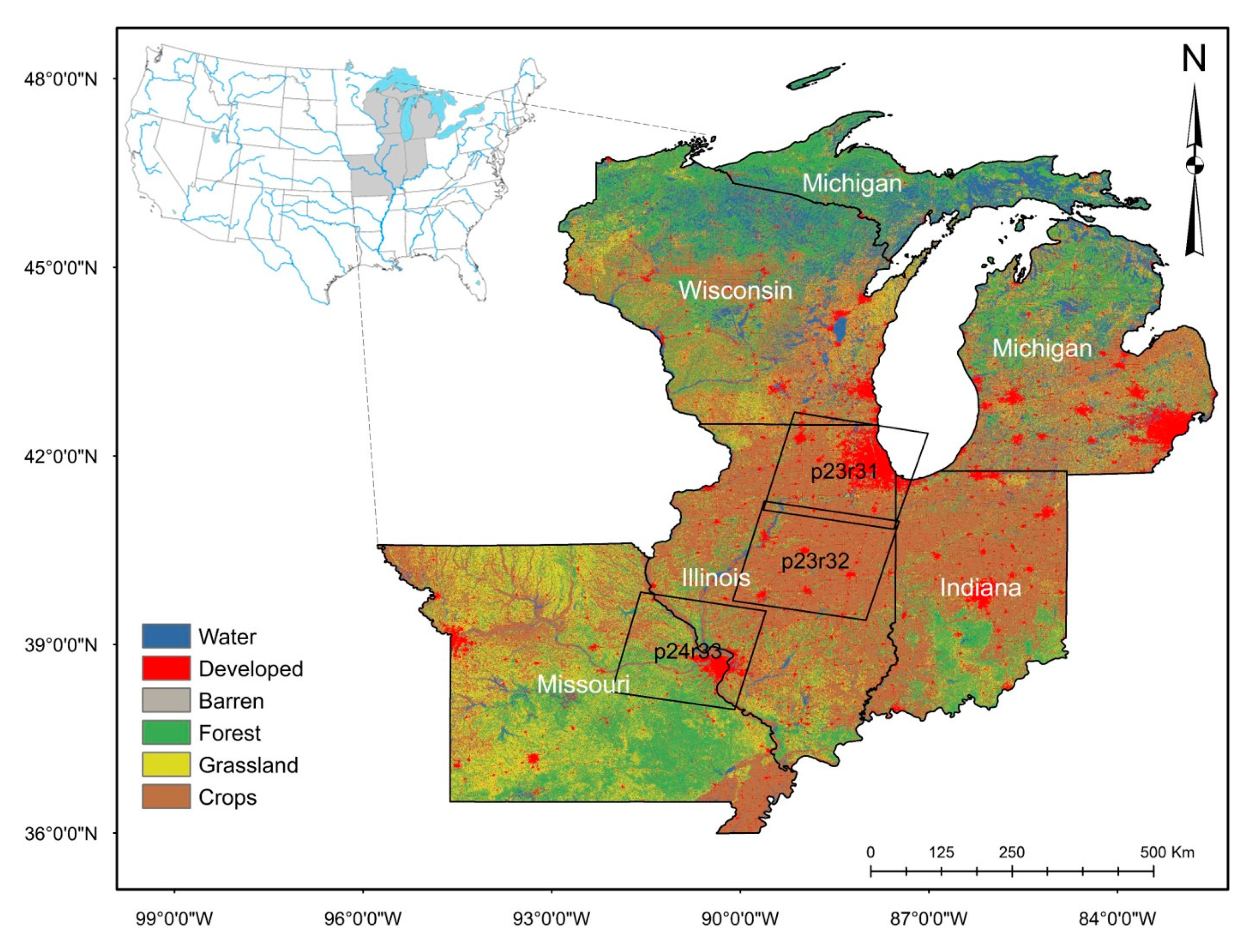
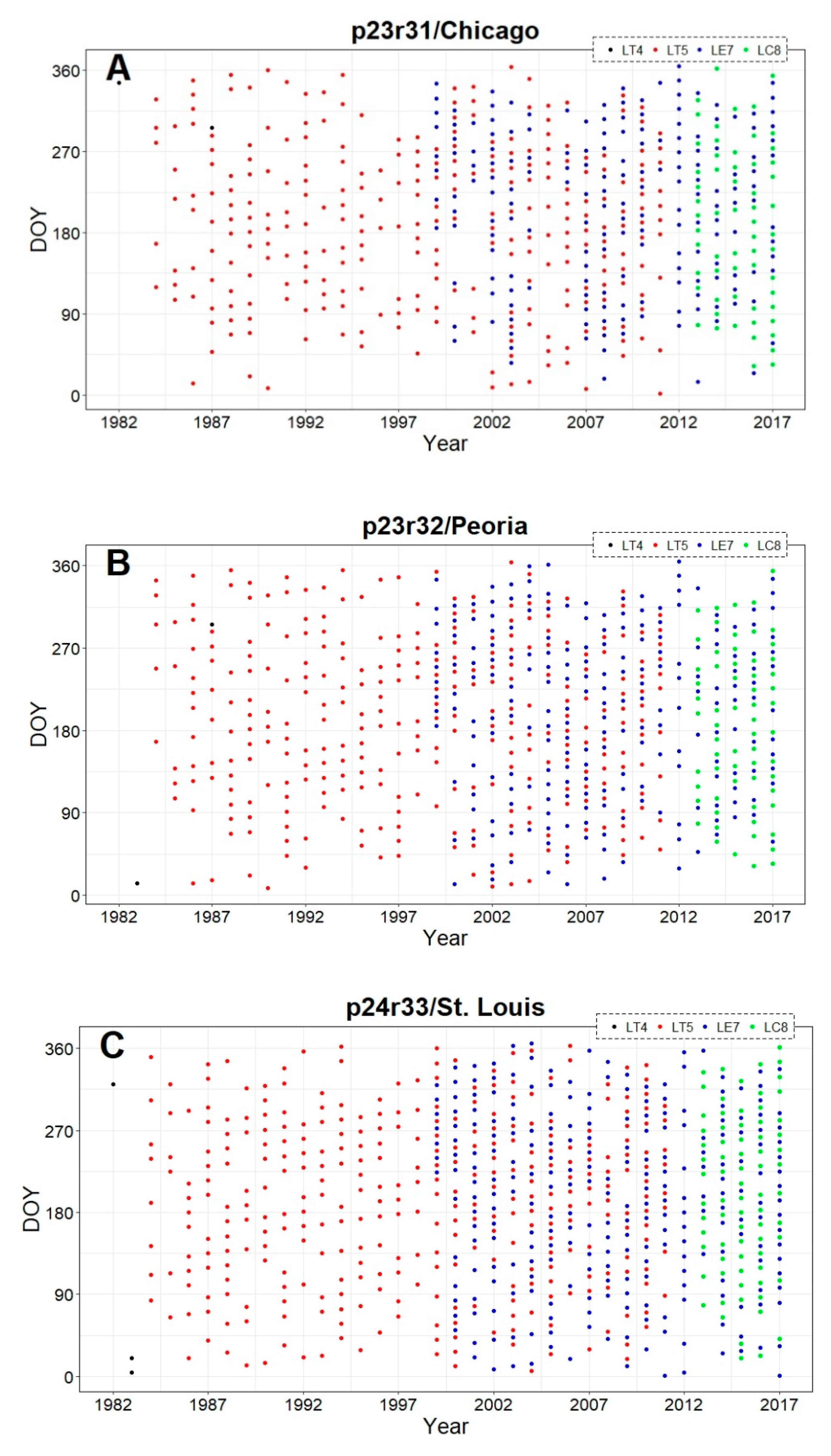
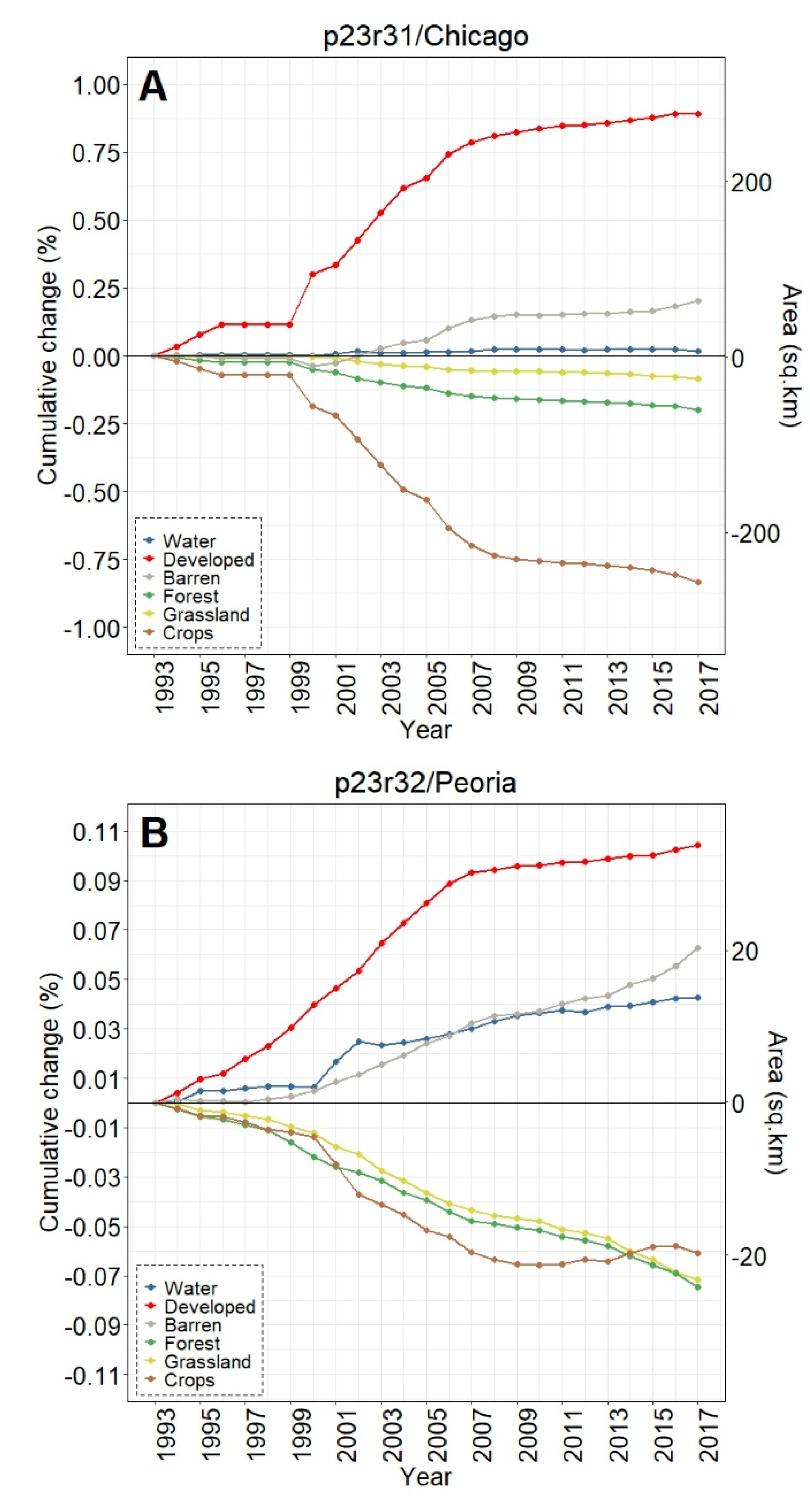
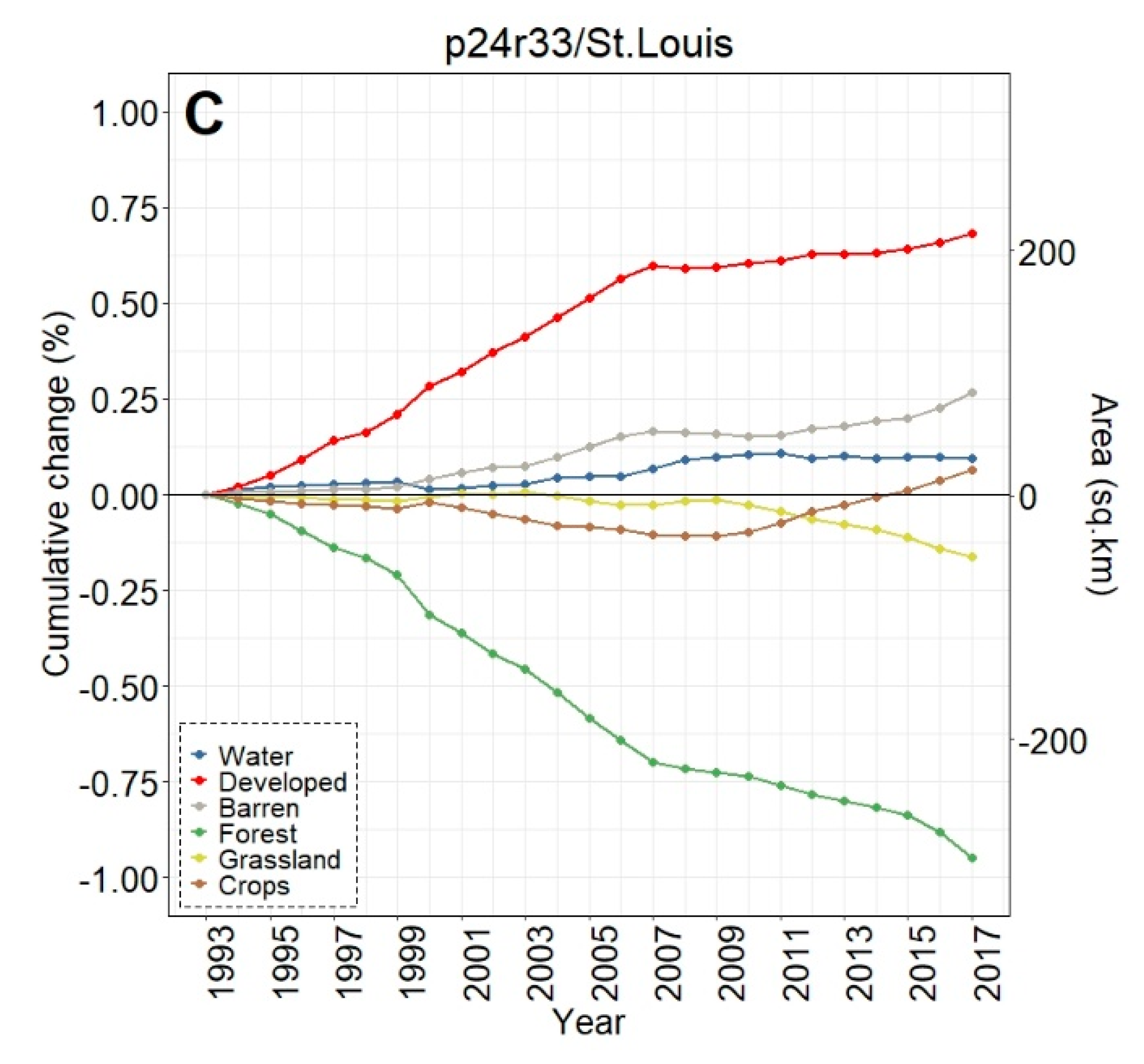
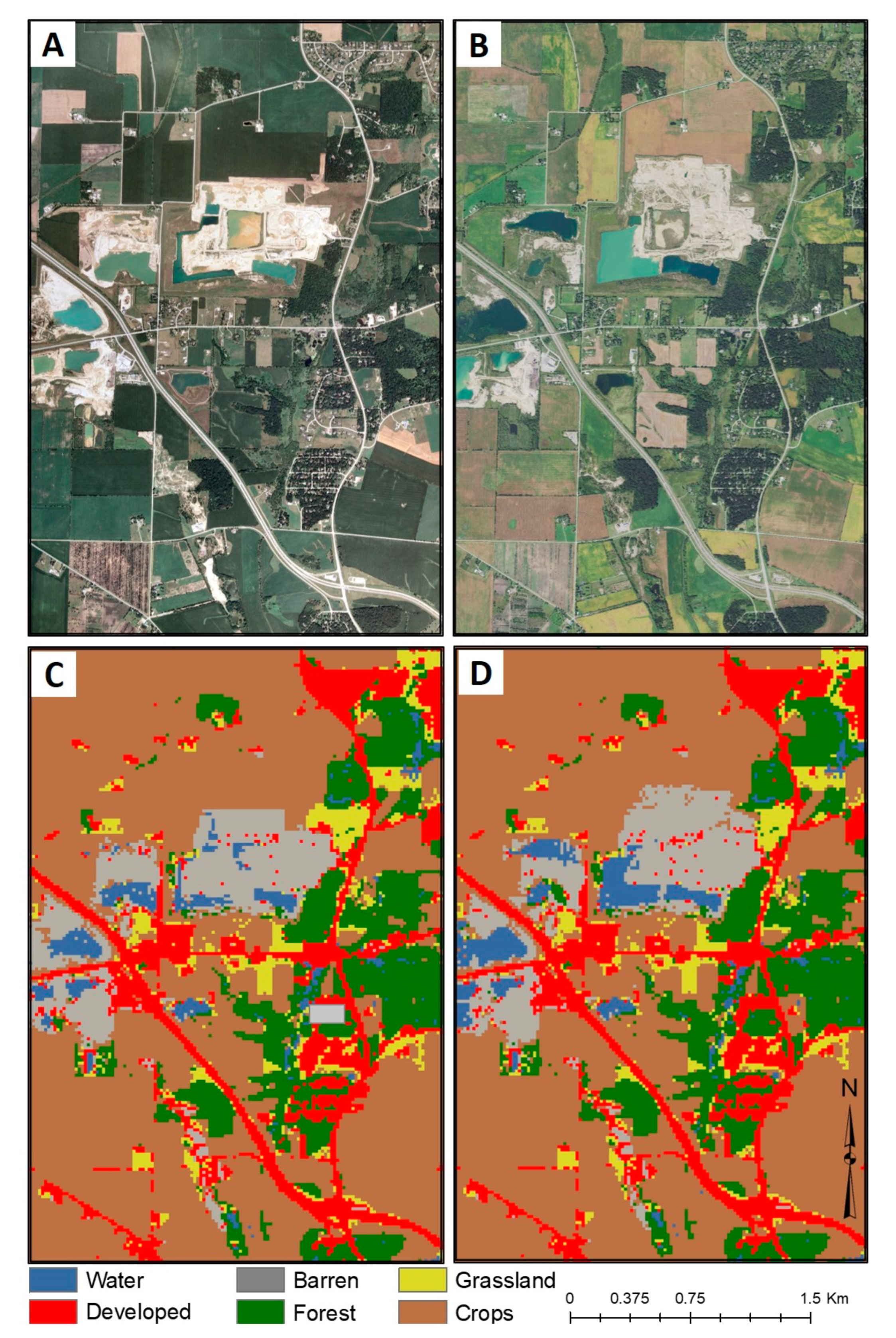
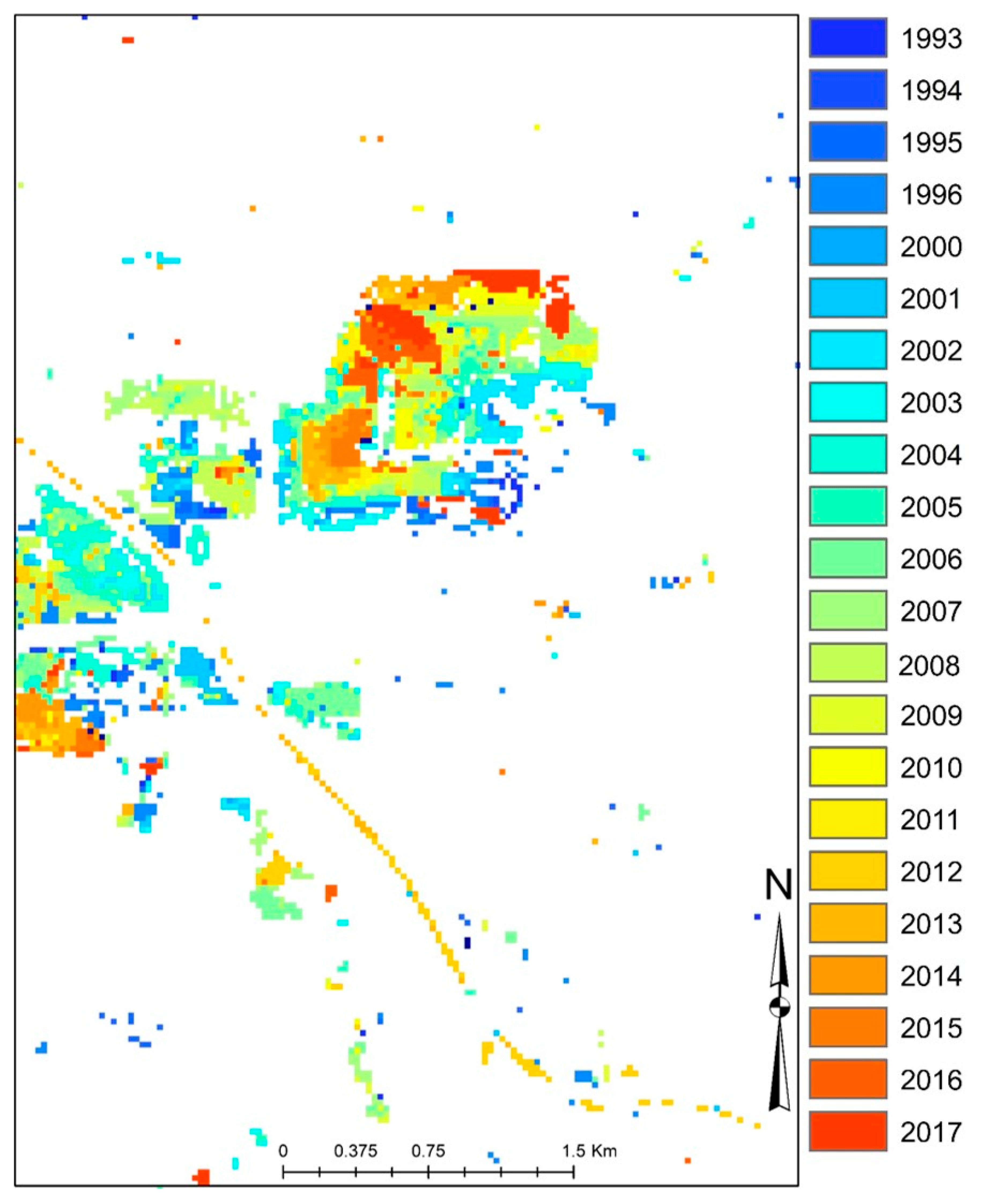

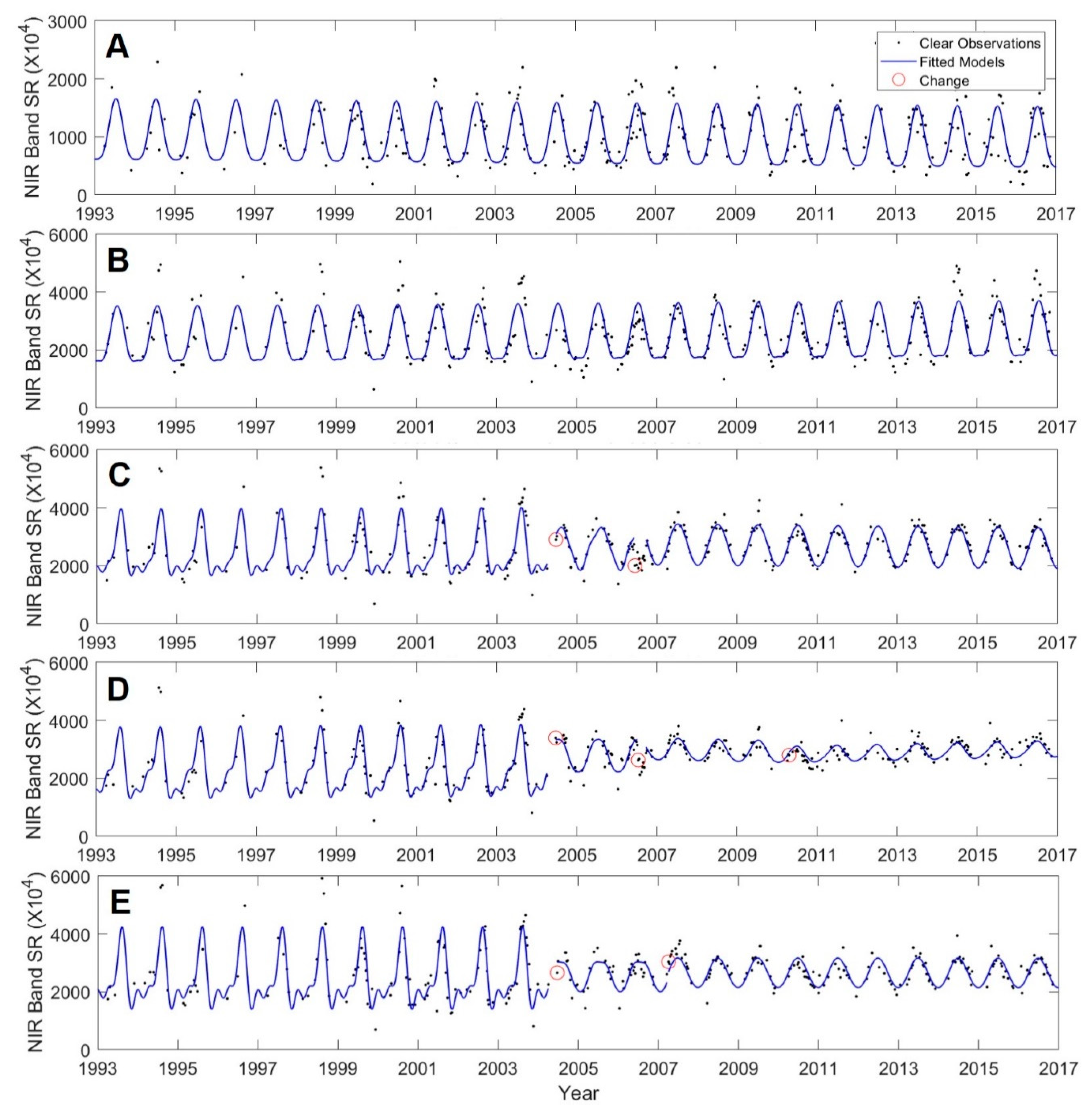
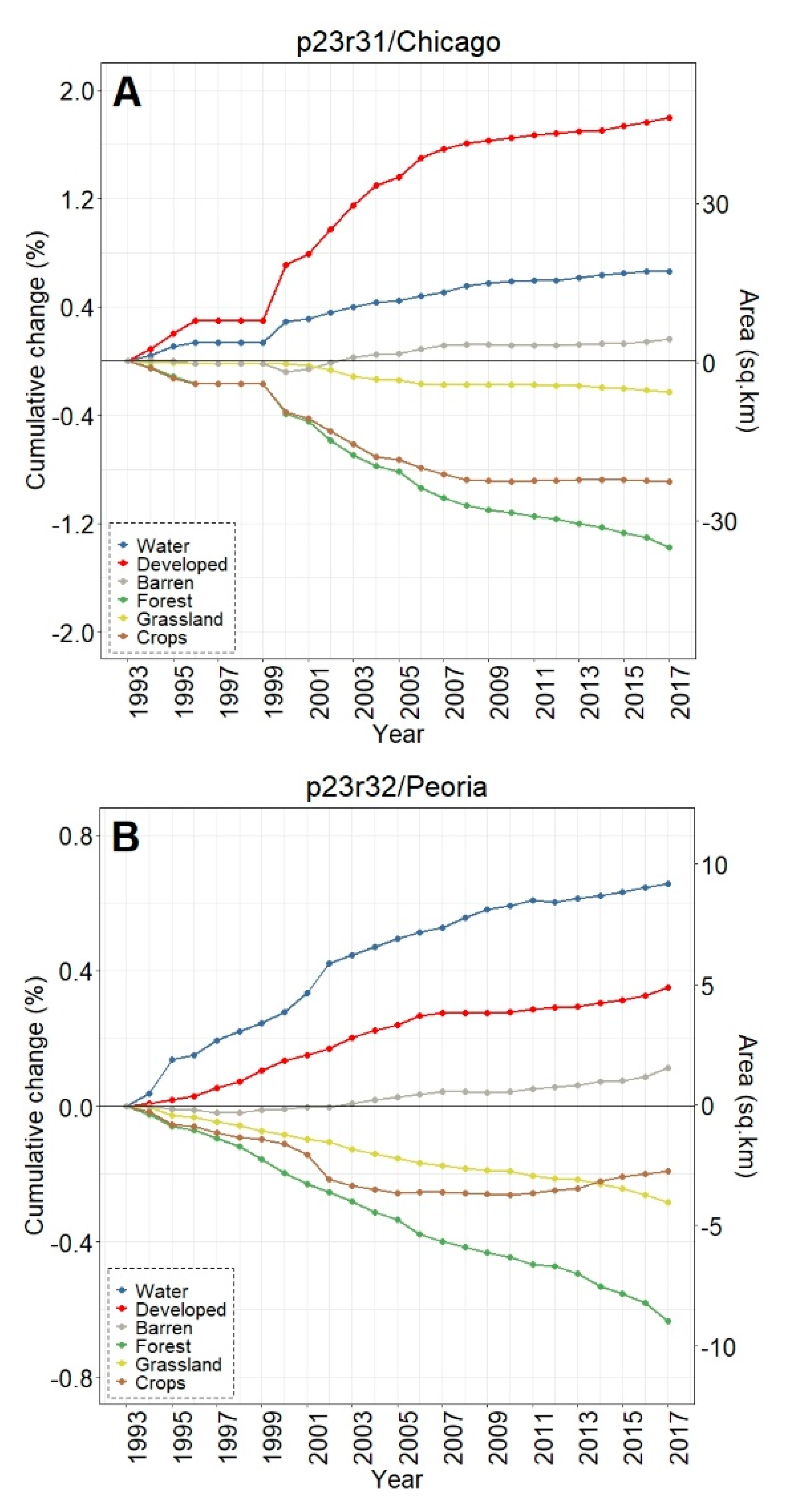
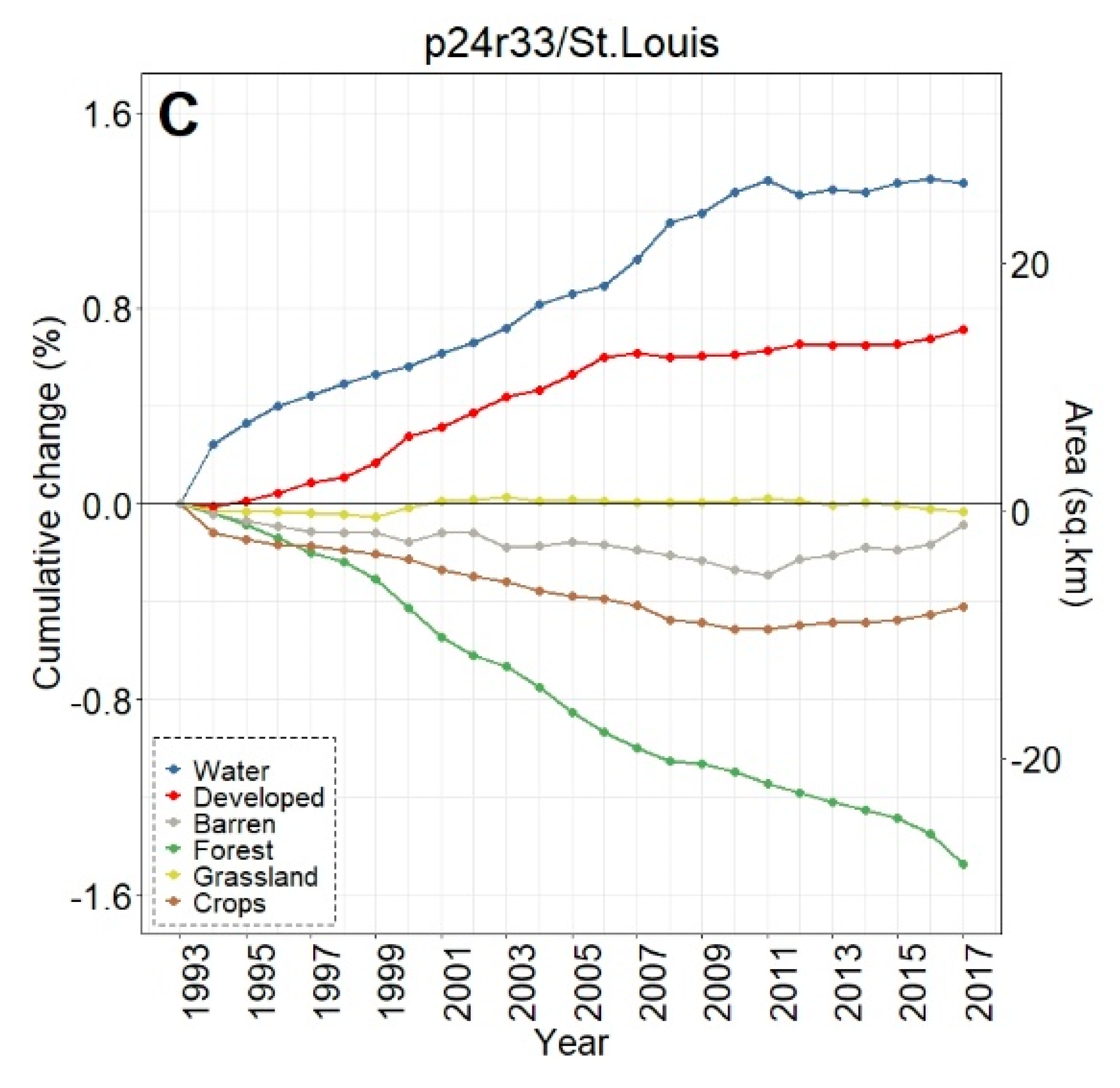
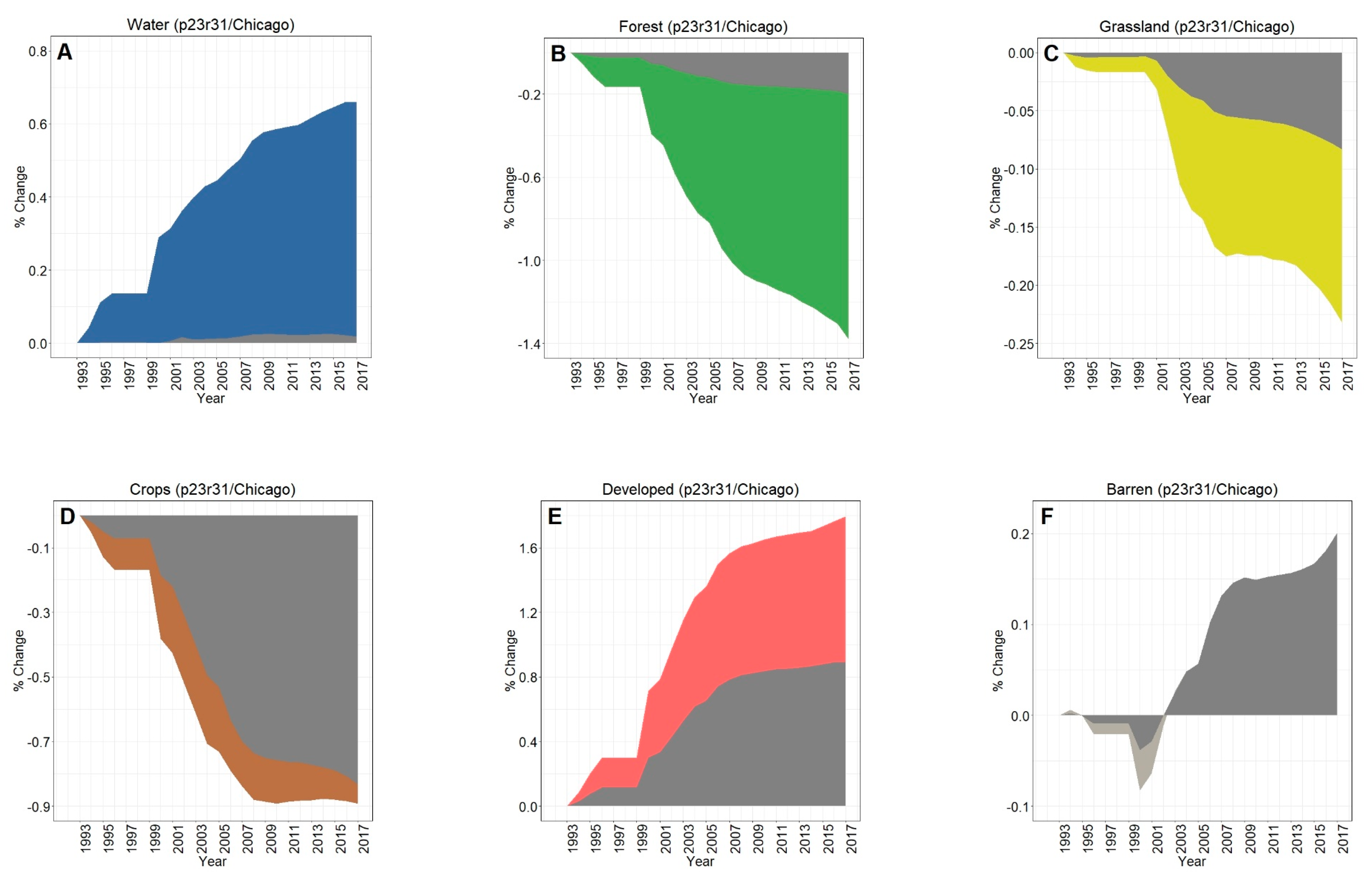
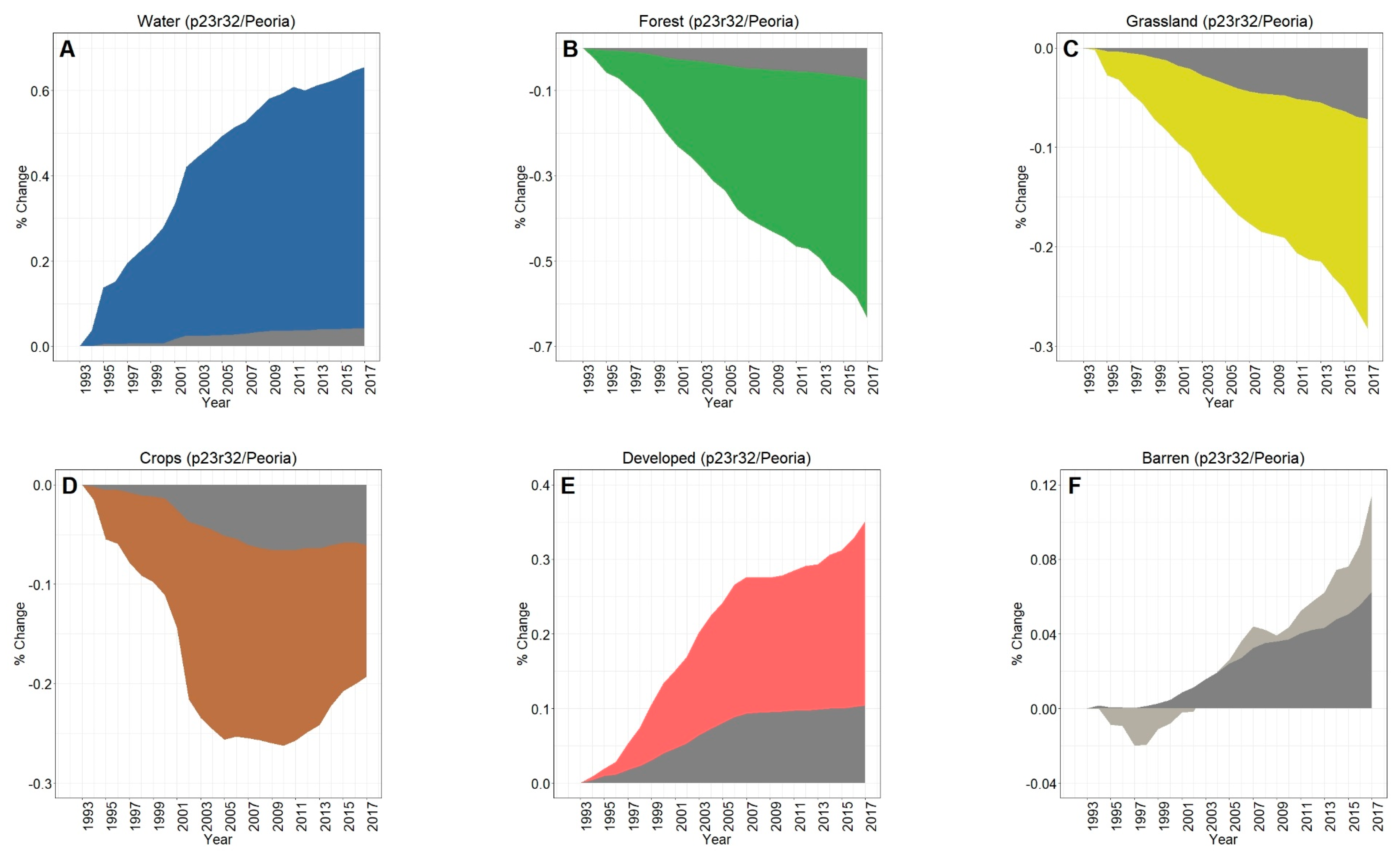
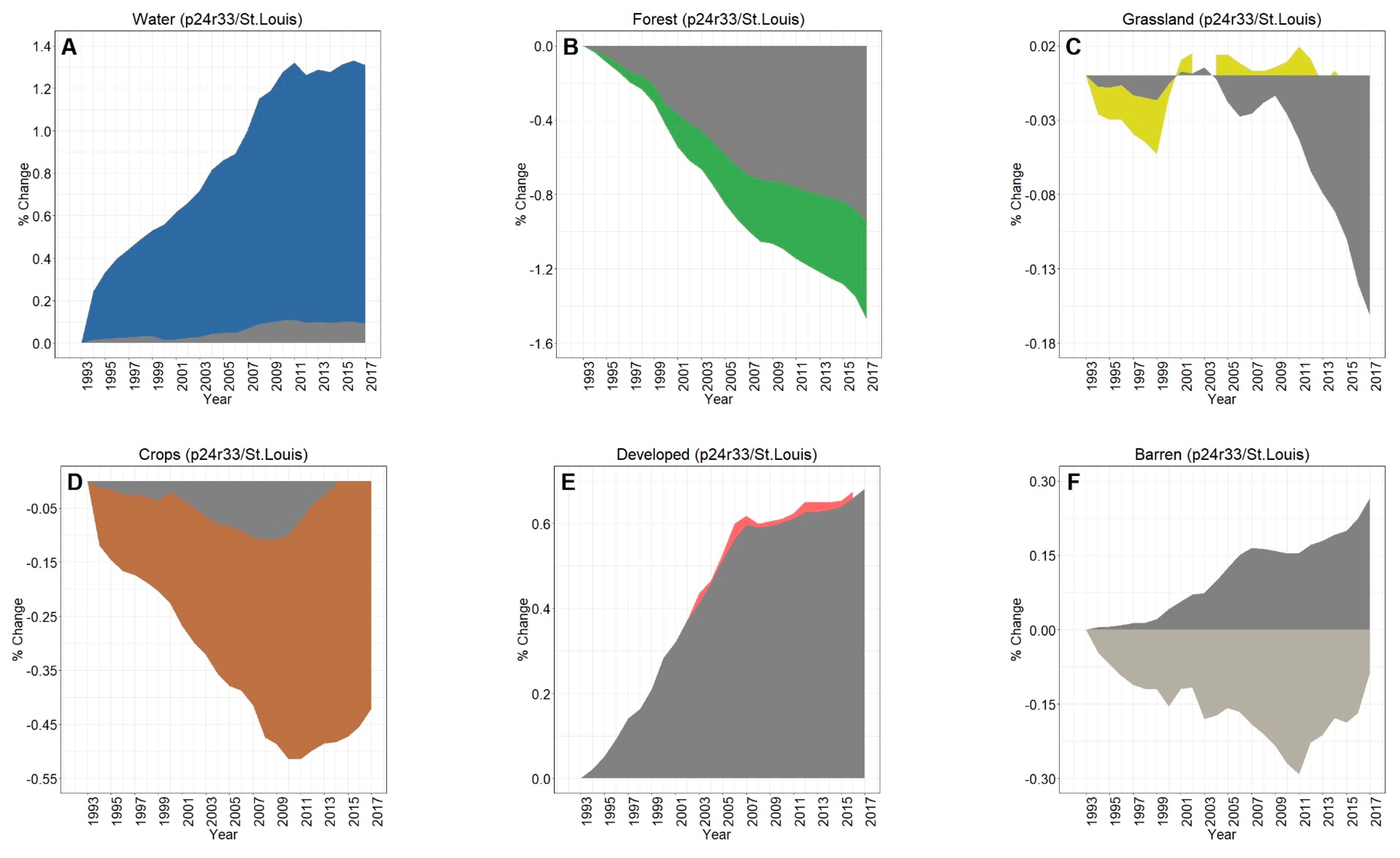
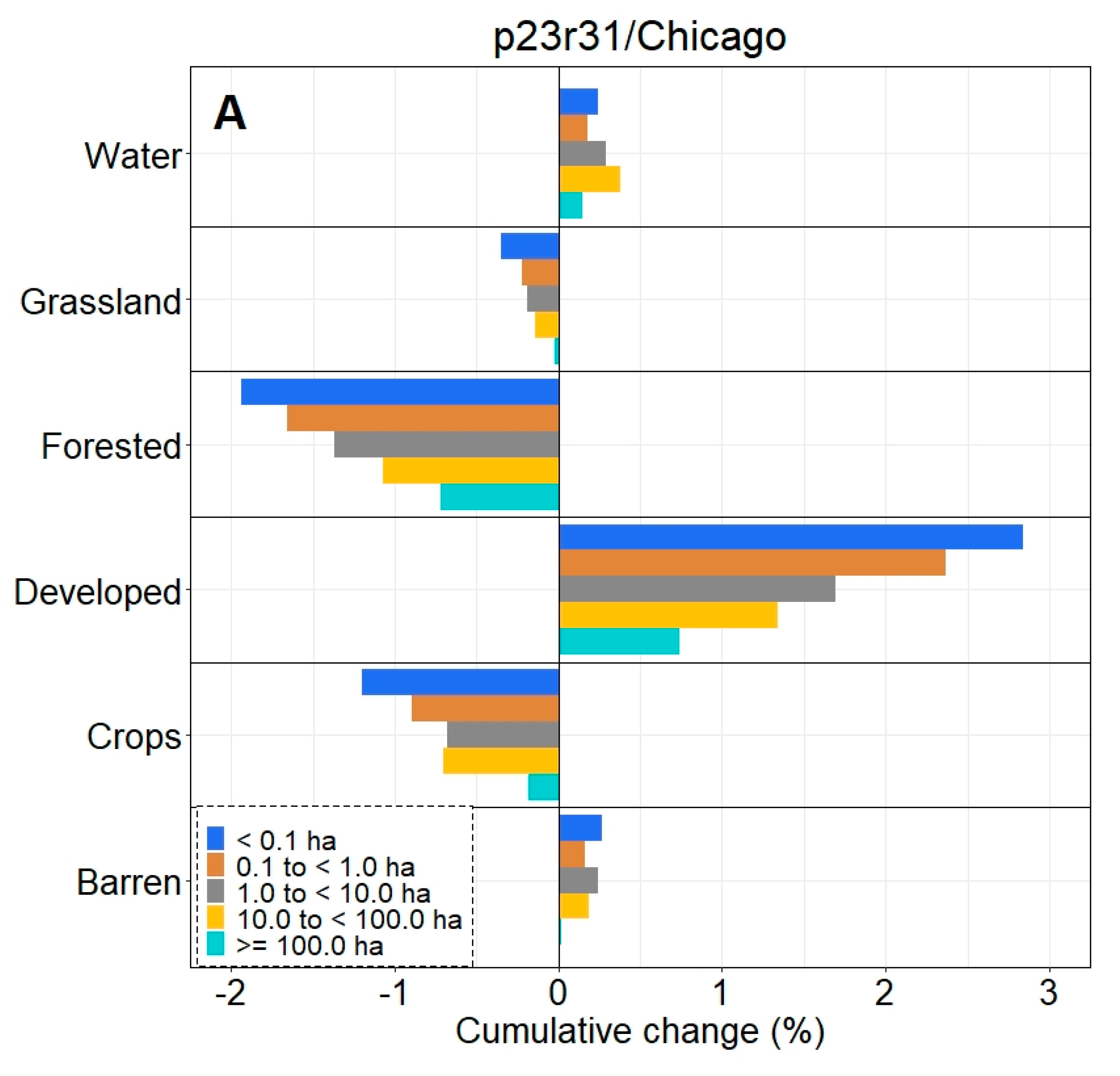
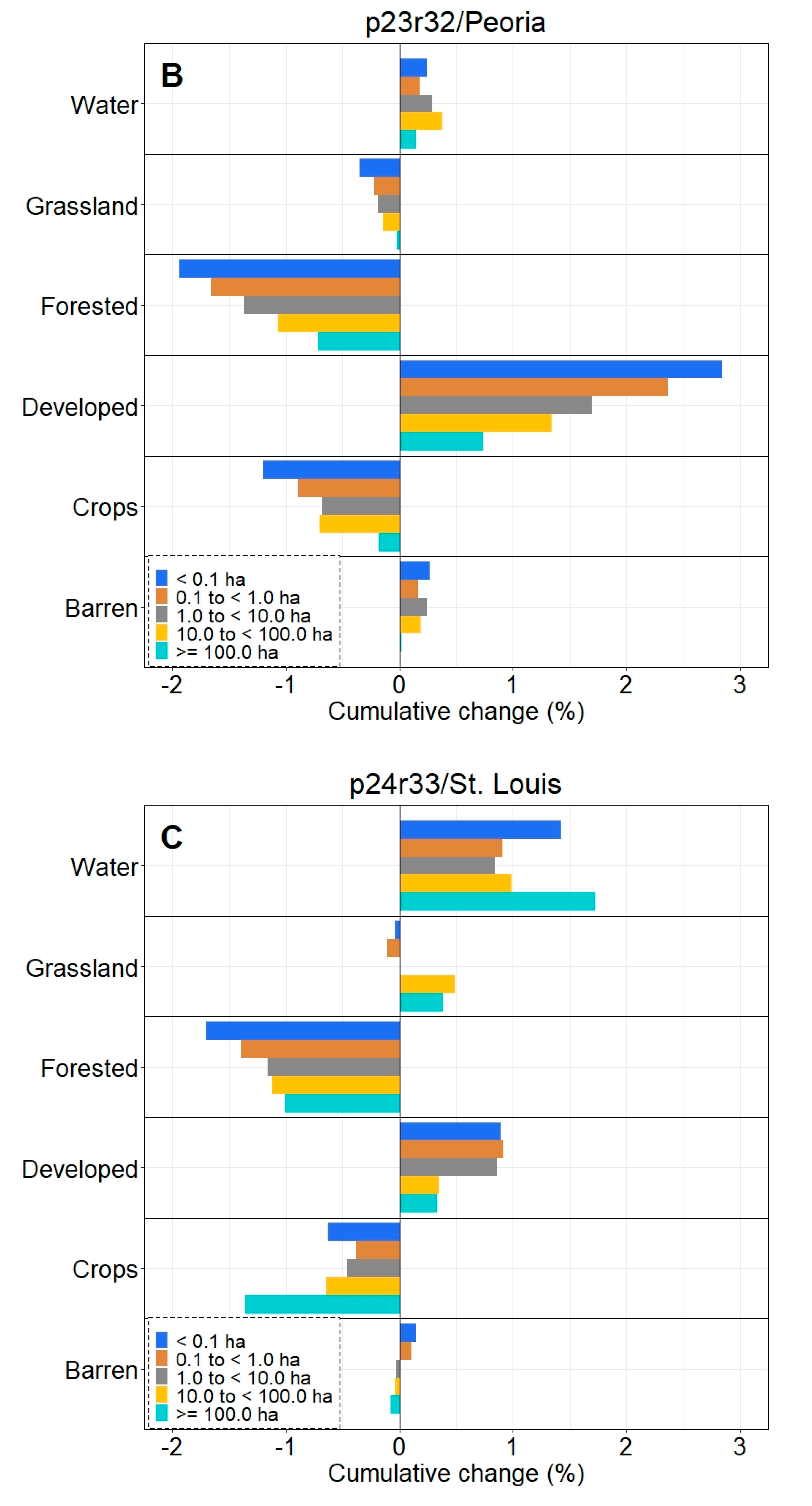
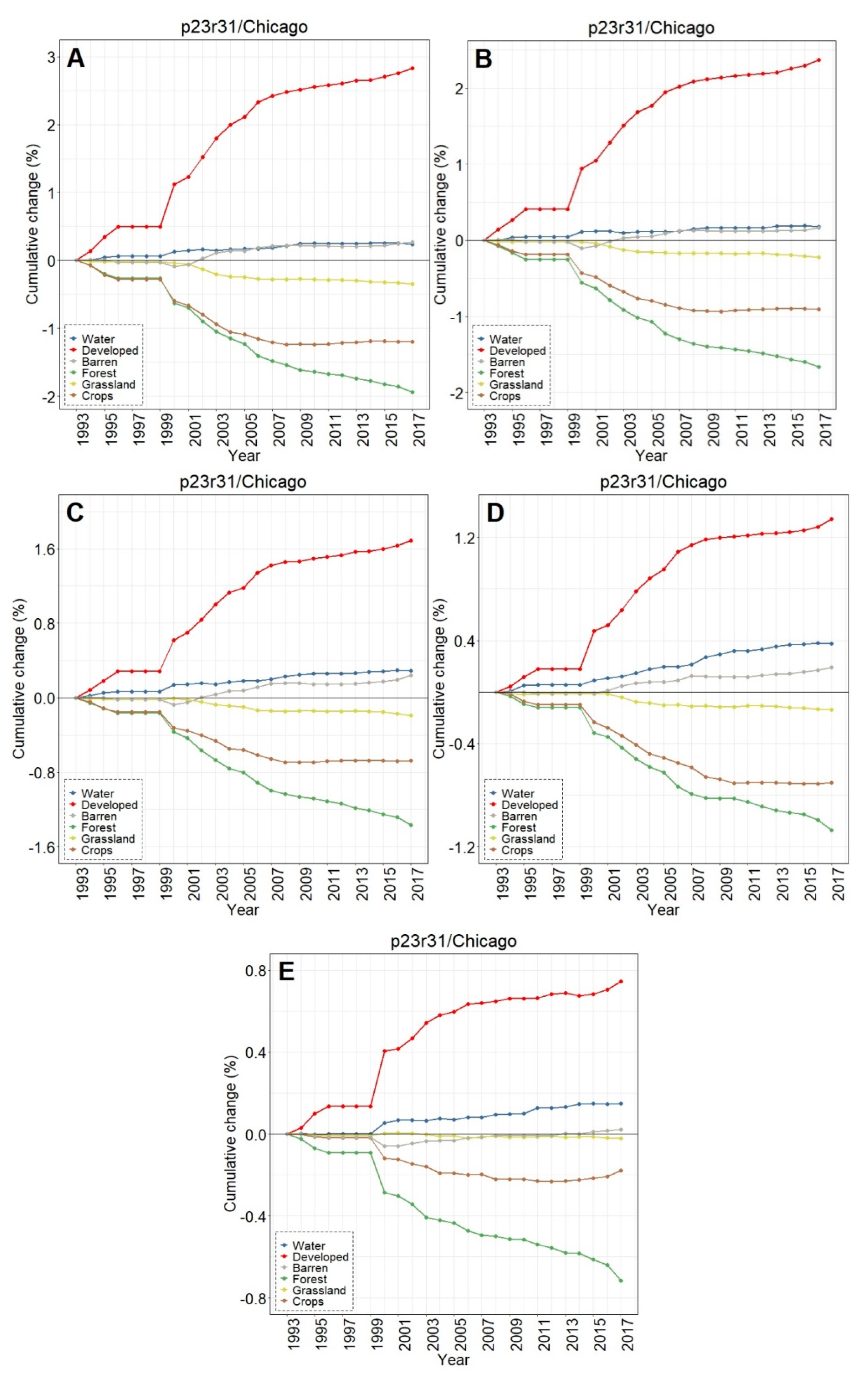
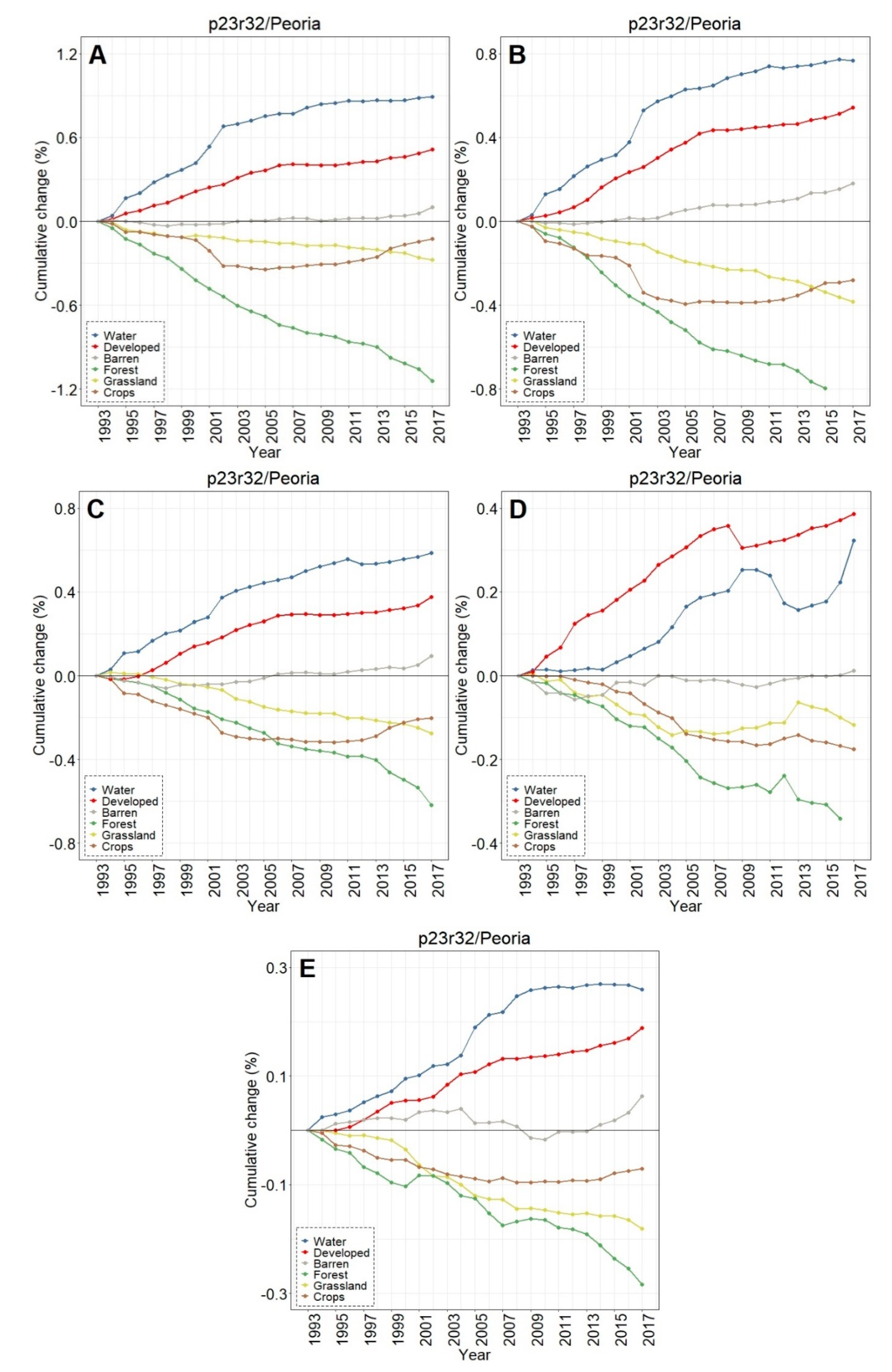
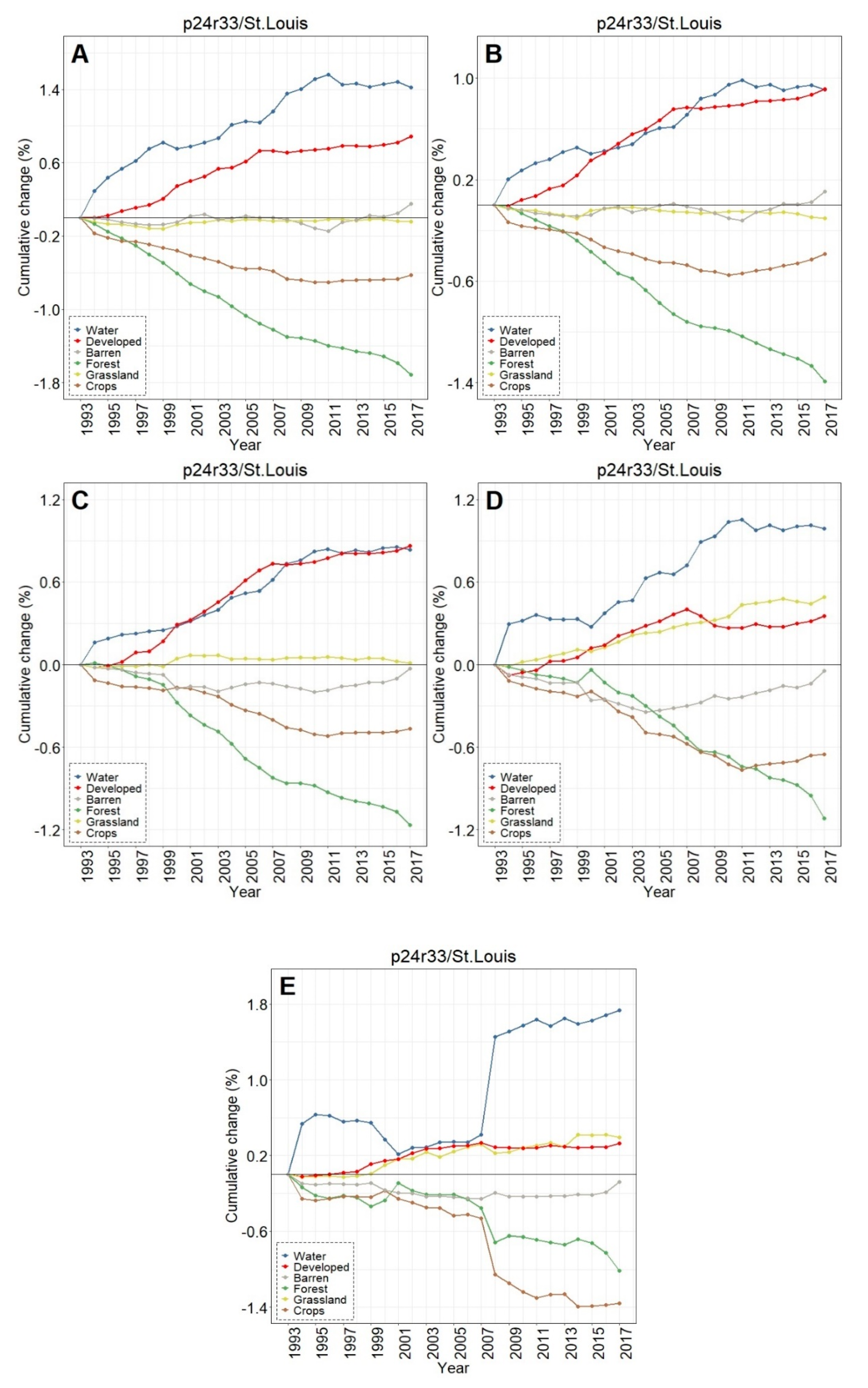
| LULC | Water | Developed | Forest | Barren | Grassland | Crops | |
|---|---|---|---|---|---|---|---|
| 2001 NLCD | Water | 2015 | 120 | 625 | 24 | 31 | 85 |
| Developed | 261 | 15,191 | 1056 | 319 | 561 | 2460 | |
| Forest | 8 | 48 | 4524 | 8 | 5 | 73 | |
| Barren | 489 | 257 | 5 | 119 | 161 | 457 | |
| Grassland | 135 | 993 | 481 | 66 | 1370 | 1814 | |
| Crops | 187 | 671 | 481 | 193 | 540 | 43,413 | |
| Producer’s Accuracy (%) | 65.1 | 87.9 | 63.1 | 16.3 | 51.3 | 89.9 | |
| User’s Accuracy (%) | 69.5 | 76.5 | 76.7 | 46.1 | 28.2 | 95.4 | |
| Overall Agreement (%) | 84.1 | ||||||
| 2006 NLCD | Water | 2026 | 120 | 610 | 22 | 30 | 81 |
| Developed | 281 | 15,764 | 1099 | 541 | 601 | 2699 | |
| Forest | 4 | 59 | 4454 | 7 | 4 | 58 | |
| Barren | 478 | 241 | 2 | 119 | 154 | 437 | |
| Grassland | 136 | 882 | 456 | 53 | 1317 | 1752 | |
| Crops | 185 | 623 | 466 | 105 | 520 | 42,870 | |
| Producer’s Accuracy (%) | 65.1 | 89.1 | 62.8 | 14.0 | 50.2 | 89.5 | |
| User’s Accuracy (%) | 70.1 | 75.1 | 77.2 | 48.4 | 28.7 | 95.8 | |
| Overall Agreement (%) | 84.0 | ||||||
| 2011 NLCD | Water | 2035 | 111 | 607 | 20 | 35 | 100 |
| Developed | 307 | 16,025 | 1159 | 618 | 631 | 2921 | |
| Forest | 10 | 53 | 4402 | 8 | 4 | 37 | |
| Barren | 480 | 235 | 2 | 108 | 172 | 458 | |
| Grassland | 128 | 778 | 418 | 43 | 1265 | 1714 | |
| Crops | 176 | 567 | 453 | 91 | 510 | 42,573 | |
| Producer’s Accuracy (%) | 64.9 | 90.2 | 62.5 | 12.2 | 48.3 | 89.1 | |
| User’s Accuracy (%) | 70.0 | 74.0 | 76.5 | 50.5 | 29.1 | 95.9 | |
| Overall Agreement (%) | 83.8 |
| LULC | Water | Developed | Forest | Barren | Grassland | Crops | |
|---|---|---|---|---|---|---|---|
| 2001 NLCD | Water | 1068 | 13 | 166 | 3 | 23 | 26 |
| Developed | 52 | 3434 | 458 | 120 | 448 | 2983 | |
| Forest | 2 | 3 | 3458 | 4 | 0 | 2 | |
| Barren | 381 | 90 | 0 | 26 | 260 | 281 | |
| Grassland | 33 | 206 | 427 | 5 | 1216 | 839 | |
| Crops | 68 | 748 | 877 | 48 | 744 | 61,363 | |
| Producer’s Accuracy (%) | 66.6 | 76.4 | 64.2 | 12.6 | 45.2 | 93.7 | |
| User’s Accuracy (%) | 82.2 | 45.8 | 77.3 | 78.8 | 44.6 | 96.1 | |
| Overall Agreement (%) | 88.3 | ||||||
| 2006 NLCD | Water | 1076 | 12 | 145 | 6 | 24 | 36 |
| Developed | 56 | 3473 | 364 | 132 | 447 | 3011 | |
| Forest | 2 | 3 | 3305 | 6 | 2 | 2 | |
| Barren | 374 | 88 | 0 | 28 | 260 | 277 | |
| Grassland | 33 | 199 | 282 | 8 | 1209 | 837 | |
| Crops | 61 | 738 | 633 | 39 | 729 | 61,122 | |
| Producer’s Accuracy (%) | 67.2 | 77.0 | 69.9 | 12.8 | 45.3 | 93.6 | |
| User’s Accuracy (%) | 82.8 | 46.4 | 76.7 | 75.7 | 47.1 | 96.5 | |
| Overall Agreement (%) | 88.9 | ||||||
| 2011 NLCD | Water | 1064 | 11 | 148 | 6 | 28 | 38 |
| Developed | 60 | 3486 | 369 | 147 | 454 | 3041 | |
| Forest | 1 | 2 | 3289 | 5 | 1 | 2 | |
| Barren | 373 | 83 | 1 | 25 | 258 | 285 | |
| Grassland | 36 | 192 | 285 | 10 | 1191 | 840 | |
| Crops | 64 | 729 | 629 | 42 | 723 | 61,086 | |
| Producer’s Accuracy (%) | 66.6 | 77.4 | 69.7 | 10.6 | 44.9 | 93.6 | |
| User’s Accuracy (%) | 82.2 | 46.1 | 76.6 | 78.1 | 46.6 | 96.5 | |
| Overall Agreement (%) | 88.8 |
| LULC | Water | Developed | Forest | Barren | Grassland | Crops | |
|---|---|---|---|---|---|---|---|
| 2001 NLCD | Water | 2292 | 57 | 980 | 77 | 57 | 140 |
| Developed | 55 | 4622 | 1585 | 151 | 1430 | 1114 | |
| Forest | 10 | 17 | 27,031 | 26 | 9 | 11 | |
| Barren | 229 | 208 | 16 | 82 | 1237 | 760 | |
| Grassland | 40 | 251 | 1834 | 39 | 9418 | 1865 | |
| Crops | 146 | 162 | 896 | 63 | 1332 | 21,011 | |
| Producer’s Accuracy (%) | 82.7 | 86.9 | 83.6 | 18.7 | 69.9 | 84.4 | |
| User’s Accuracy (%) | 63.6 | 51.6 | 91.7 | 56.6 | 70.0 | 89.0 | |
| Overall Agreement (%) | 81.3 | ||||||
| 2006 NLCD | Water | 2315 | 60 | 988 | 70 | 52 | 226 |
| Developed | 62 | 4779 | 1594 | 189 | 1449 | 1151 | |
| Forest | 13 | 15 | 26,820 | 49 | 11 | 10 | |
| Barren | 220 | 235 | 12 | 87 | 1267 | 731 | |
| Grassland | 45 | 260 | 1825 | 49 | 9356 | 1862 | |
| Crops | 148 | 163 | 883 | 68 | 1315 | 20,874 | |
| Producer’s Accuracy (%) | 82.6 | 86.7 | 83.5 | 17.0 | 69.6 | 84.0 | |
| User’s Accuracy (%) | 62.4 | 51.8 | 91.5 | 58.8 | 69.8 | 89.0 | |
| Overall Agreement (%) | 81.0 | ||||||
| 2011 NLCD | Water | 2365 | 50 | 978 | 63 | 53 | 223 |
| Developed | 69 | 4884 | 1628 | 198 | 1485 | 1189 | |
| Forest | 13 | 16 | 26,712 | 52 | 12 | 9 | |
| Barren | 215 | 217 | 14 | 90 | 1279 | 724 | |
| Grassland | 54 | 240 | 1824 | 50 | 9202 | 1844 | |
| Crops | 137 | 146 | 880 | 72 | 1405 | 20,861 | |
| Producer’s Accuracy (%) | 82.9 | 88.0 | 83.4 | 17.1 | 68.5 | 83.9 | |
| User’s Accuracy (%) | 63.4 | 51.7 | 91.5 | 58.4 | 69.6 | 88.8 | |
| Overall Agreement (%) | 80.9 |
| Chicago Footprint | ||||
| Size (ha) | Count | Area (ha) | Average (ha) | Standard Deviation (ha) |
| <0.1 | 22,877 | 2058.9 | 0.1 | 0 |
| 0.1 to <1.0 | 21,828 | 7921.3 | 0.4 | 0.3 |
| 1.0 to <10.0 | 6019 | 17,631.6 | 2.9 | 2.1 |
| 10.0 to <100.0 | 822 | 21,582.8 | 26.3 | 19.5 |
| ≥ 100.0 | 73 | 20,612.1 | 282.4 | 303.9 |
| All | 51,619 | 69,806.7 | 1.4 | 16.1 |
| Peoria Footprint | ||||
| Size (ha) | Count | Area (ha) | Average (ha) | Standard Deviation (ha) |
| <0.1 | 8821 | 793.9 | 0.1 | 0 |
| 0.1 to <1.0 | 10,120 | 3785.3 | 0.4 | 0.2 |
| 1.0 to <10.0 | 2842 | 8015.4 | 2.8 | 2.0 |
| 10.0 to <100.0 | 363 | 9247.2 | 25.5 | 18.9 |
| ≥ 100.0 | 40 | 21,826.7 | 545.7 | 74.2 |
| All | 22,186 | 43,668.5 | 2.0 | 39.0 |
| St. Louis Footprint | ||||
| Size (ha) | Count | Area (ha) | Average (ha) | Standard Deviation (ha) |
| <0.1 | 14,291 | 1286.2 | 0.09 | 0 |
| 0.1 to <1.0 | 15,869 | 5895.4 | 0.4 | 0.2 |
| 1.0 to <10.0 | 3920 | 10,511.2 | 2.7 | 1.9 |
| 10.0 to <100.0 | 365 | 9064.4 | 24.8 | 18.4 |
| ≥ 100.0 | 30 | 6958.1 | 231.9 | 209.8 |
| All | 34,475 | 33,715.4 | 1.0 | 9.7 |
© 2020 by the authors. Licensee MDPI, Basel, Switzerland. This article is an open access article distributed under the terms and conditions of the Creative Commons Attribution (CC BY) license (http://creativecommons.org/licenses/by/4.0/).
Share and Cite
Berhane, T.M.; Lane, C.R.; Mengistu, S.G.; Christensen, J.; Golden, H.E.; Qiu, S.; Zhu, Z.; Wu, Q. Land-Cover Changes to Surface-Water Buffers in the Midwestern USA: 25 Years of Landsat Data Analyses (1993–2017). Remote Sens. 2020, 12, 754. https://doi.org/10.3390/rs12050754
Berhane TM, Lane CR, Mengistu SG, Christensen J, Golden HE, Qiu S, Zhu Z, Wu Q. Land-Cover Changes to Surface-Water Buffers in the Midwestern USA: 25 Years of Landsat Data Analyses (1993–2017). Remote Sensing. 2020; 12(5):754. https://doi.org/10.3390/rs12050754
Chicago/Turabian StyleBerhane, Tedros M., Charles R. Lane, Samson G. Mengistu, Jay Christensen, Heather E. Golden, Shi Qiu, Zhe Zhu, and Qiusheng Wu. 2020. "Land-Cover Changes to Surface-Water Buffers in the Midwestern USA: 25 Years of Landsat Data Analyses (1993–2017)" Remote Sensing 12, no. 5: 754. https://doi.org/10.3390/rs12050754
APA StyleBerhane, T. M., Lane, C. R., Mengistu, S. G., Christensen, J., Golden, H. E., Qiu, S., Zhu, Z., & Wu, Q. (2020). Land-Cover Changes to Surface-Water Buffers in the Midwestern USA: 25 Years of Landsat Data Analyses (1993–2017). Remote Sensing, 12(5), 754. https://doi.org/10.3390/rs12050754






